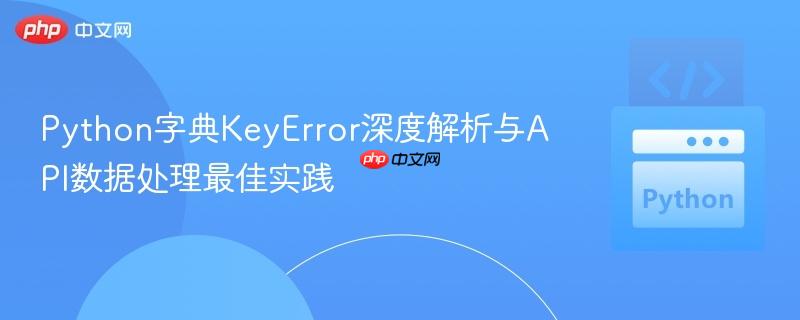
本文深入探讨了在python处理api响应数据时常见的`keyerror`,特别是当键看似存在却报错的情况。文章提供了有效的调试策略,包括数据结构检查和循环索引分析,并介绍了如何利用`try-except`语句和`dict.get()`方法实现健壮的错误处理,旨在帮助开发者更稳定、高效地处理动态api数据。
KeyError是Python字典操作中一个非常常见的异常,它表示您尝试访问字典中一个不存在的键。在处理来自API的JSON数据时,尽管原始数据样本中某个键可能存在,但在实际运行时,由于数据结构的不一致性、API响应变化或逻辑错误,KeyError依然可能发生。
导致KeyError的常见原因包括:
当遇到KeyError时,最有效的调试方法是逐步检查数据结构和程序逻辑。
在尝试访问深层嵌套的键之前,逐步打印出中间层的数据是定位问题的关键。例如,在代码中尝试访问result["data"][match_number]["teamInfo"]之前,可以先打印result["data"][match_number]。
立即学习“Python免费学习笔记(深入)”;
import requests
api_key = "YOUR_API_KEY" # 请替换为您的实际API密钥
url_currentmatches = f"https://api.cricapi.com/v1/cricScore?apikey={api_key}"
try:
response = requests.get(url_currentmatches)
response.raise_for_status() # 检查HTTP请求是否成功
result = response.json()
except requests.exceptions.RequestException as e:
print(f"API请求失败: {e}")
exit()
except ValueError:
print("API响应不是有效的JSON格式。")
exit()
if not result or "data" not in result or not isinstance(result["data"], list):
print("API响应数据格式不符合预期。")
exit()
amount_of_matches = len(result["data"])
match_number = 0 # 初始索引应从0开始
while match_number < amount_of_matches:
current_match_data = result["data"][match_number]
# 关键调试步骤:打印当前处理的比赛数据
print(f"\n--- 正在处理第 {match_number} 场比赛的数据 ---")
print(current_match_data)
# 检查 'teamInfo' 键是否存在
if "teamInfo" in current_match_data:
try:
name1 = current_match_data["teamInfo"][0]["name"]
name2 = current_match_data["teamInfo"][1]["name"]
important_countries = ["Pakistan","New Zealand","Australia","Sri Lanka","South Africa","West Indies","England","India"]
for country in important_countries:
if country in name1 or country in name2: # 使用更简洁的 'in' 操作符
print(f"国家匹配: {name1} vs {name2} (涉及国家: {country})")
break # 找到一个匹配即可
else:
print(f"未找到重要国家匹配: {name1} vs {name2}")
except IndexError:
print(f"KeyError: 'teamInfo' 列表索引超出范围,可能缺少队伍信息。比赛ID: {current_match_data.get('id', '未知')}")
except KeyError as e:
print(f"KeyError: 无法访问 'teamInfo' 下的键 '{e}'。比赛ID: {current_match_data.get('id', '未知')}")
else:
print(f"警告: 当前比赛数据中缺少 'teamInfo' 键。比赛ID: {current_match_data.get('id', '未知')}")
match_number += 1通过打印current_match_data,您可以直观地看到每个比赛条目包含哪些键,从而判断"teamInfo"键是否真的在所有条目中都存在。
原始代码中的循环逻辑存在一个细微但关键的问题:
match_number=-1
amount_of_matches = len(result["data"])
while True:
match_number += 1 # 在这里递增
if match_number == amount_of_matches:
break
else:
name1 = result["data"][match_number]["teamInfo"][0]["name"] # 第一次访问时 match_number 已经是 0
# ...当while True循环第一次执行时,match_number从-1变为0。然后,代码会尝试访问result["data"][0]。这意味着result["data"][0]是第一个被访问的元素,而不是像原始答案中提到的result["data"][0]被跳过。
然而,如果result["data"]为空列表,或者match_number在其他地方被错误地修改,仍然可能导致问题。更推荐的循环方式是使用for循环或确保match_number的初始化和递增逻辑清晰。
正确的循环方式:
# 使用 for 循环遍历列表元素,更Pythonic且不易出错
for i, match_data in enumerate(result["data"]):
# 在这里处理 match_data,即 result["data"][i]
print(f"\n--- 正在处理第 {i} 场比赛的数据 ---")
print(match_data)
if "teamInfo" in match_data:
try:
name1 = match_data["teamInfo"][0]["name"]
name2 = match_data["teamInfo"][1]["name"]
# ... 后续处理逻辑
except (IndexError, KeyError) as e:
print(f"处理比赛 {i} 时发生错误: {e}")
else:
print(f"警告: 第 {i} 场比赛缺少 'teamInfo' 键。")为了使代码更健壮,即使在数据结构不一致的情况下也能正常运行,可以采用以下两种方法:
try-except块允许您“尝试”执行可能引发错误的代码,并在错误发生时“捕获”并处理它,而不是让程序崩溃。
for match_data in result["data"]:
try:
name1 = match_data["teamInfo"][0]["name"]
name2 = match_data["teamInfo"][1]["name"]
# ... 正常处理逻辑
print(f"成功获取队伍名称: {name1} vs {name2}")
except KeyError as e:
print(f"警告: 缺少键 '{e}'。当前比赛数据可能不完整。")
# 可以选择跳过当前比赛或记录错误
continue
except IndexError:
print("警告: 'teamInfo' 列表索引超出范围,可能缺少队伍信息。")
continuedict.get(key, default_value)方法是访问字典键的更安全方式。如果key存在,它返回对应的值;如果key不存在,它返回default_value(默认为None),而不会引发KeyError。
for match_data in result["data"]:
team_info = match_data.get("teamInfo")
if team_info and isinstance(team_info, list) and len(team_info) >= 2:
name1 = team_info[0].get("name")
name2 = team_info[1].get("name")
if name1 and name2: # 确保名称也存在
print(f"成功获取队伍名称: {name1} vs {name2}")
# ... 后续处理逻辑
else:
print("警告: 'teamInfo' 中队伍名称缺失。")
else:
print("警告: 缺少 'teamInfo' 键或其结构不符合预期。")这种方法通过链式get()调用和类型/长度检查,提供了非常细粒度的控制,可以优雅地处理各种数据缺失情况。
处理API响应数据时,KeyError是常见的挑战。解决和预防此类错误的关键在于:
通过采纳这些实践,您可以构建出更稳定、更适应动态API数据变化的应用程序。
以上就是Python字典KeyError深度解析与API数据处理最佳实践的详细内容,更多请关注php中文网其它相关文章!

每个人都需要一台速度更快、更稳定的 PC。随着时间的推移,垃圾文件、旧注册表数据和不必要的后台进程会占用资源并降低性能。幸运的是,许多工具可以让 Windows 保持平稳运行。

Copyright 2014-2025 https://www.php.cn/ All Rights Reserved | php.cn | 湘ICP备2023035733号